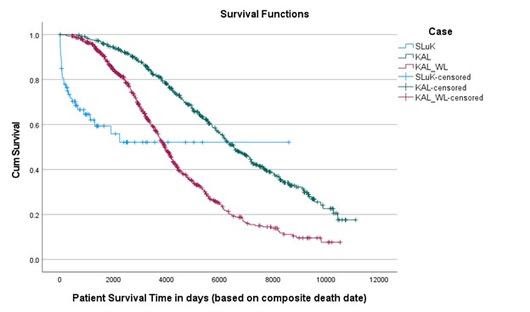Benefit of Kidney Transplantation for Post Lung Transplantation Renal Failure: Need for Priority Allocation
1Temple University Hospital, Philadelphia, PA, 2-, Garnet Valley, PA
Meeting: 2022 American Transplant Congress
Abstract number: 716
Keywords: Lung transplantation
Topic: Clinical Science » Kidney » 31 - Kidney Deceased Donor Allocation
Session Information
Session Name: Kidney Deceased Donor Allocation
Session Type: Poster Abstract
Date: Saturday, June 4, 2022
Session Time: 5:30pm-7:00pm
 Presentation Time: 5:30pm-7:00pm
Presentation Time: 5:30pm-7:00pm
Location: Hynes Halls C & D
*Purpose: Nephrotoxicity is a major side effect of thoracic transplantation. Many patients will eventually require renal transplantation (KAL) to manage their developing ESRD. Recently, simultaneous lung/kidney transplants (SLuK) is an increasingly attractive option for patients with ESRD at time of lung transplant. We examined outcomes of SLuK compared to conventional KAL, as well as differences among patients who underwent KAL and those lung transplanted patients awaiting kidney transplantation.
*Methods: The UNOS/OPTN database was used to identify patients who received SLuK transplants (n=74), patients who received KAL transplants (n=456) and patients who required a kidney transplant after lung transplant but who were never transplanted (n=626). SPSS Statistical software was used and propensity matching(PSM) was applied to reduce selection bias between study groups. The standardized mean difference was used to evaluate the balance of covariates after PSM. Demographic data were analyzed using Fisher’s exact test or chi-square test, as appropriate.
*Results: The SLuK cohort was older (p=.04), diabetic (p<.001), had a higher BMI (p=.016),and serum creatinine levels (2.28 vs. 0.9) (p<.001), and had shorter life expectancies (633 vs. 5023 days) (p<.001) than their KAL counterparts at the time of lung transplantation. KAL compared to those waitlisted, the KAL cohort was statistically younger (p<.001) and had a lower BMI at both lung transplantation (20.83 vs. 23.65) and kidney transplant/waitlist end (both p<.001). Additionally, the KAL group was more likely to have diabetes at the time of lung transplantation (p<.001), as well as more likely to require dialysis at both lung transplantation (p<.001) and kidney transplantation. Those who received a kidney transplant had a longer survival time than their WL counterparts from lung transplant (5023 vs. 3122 days), as well as a shorter median stay on the waitlist (208 vs. 656 days) (p<.001).
*Conclusions: KAL is favorable for the average lung transplant recipient, however improvements in SLuK have made simultaneous transplantation a viable option for patients with significant renal dysfunction. KAL recipients were better candidates than those who remained on the waitlist, in that they were both younger and had lower BMI’s while also displaying a more urgent need for a kidney transplant by virtue of being more likely to be diabetic and on dialysis. Priority for KAL patients in organ allocation algorithms should be considered.
To cite this abstract in AMA style:
Karhadkar S, Gregor A, Jonathan K, Dawes J, Diamond A, Wirshup K, DiCarlo A. Benefit of Kidney Transplantation for Post Lung Transplantation Renal Failure: Need for Priority Allocation [abstract]. Am J Transplant. 2022; 22 (suppl 3). https://atcmeetingabstracts.com/abstract/benefit-of-kidney-transplantation-for-post-lung-transplantation-renal-failure-need-for-priority-allocation/. Accessed December 23, 2025.« Back to 2022 American Transplant Congress

